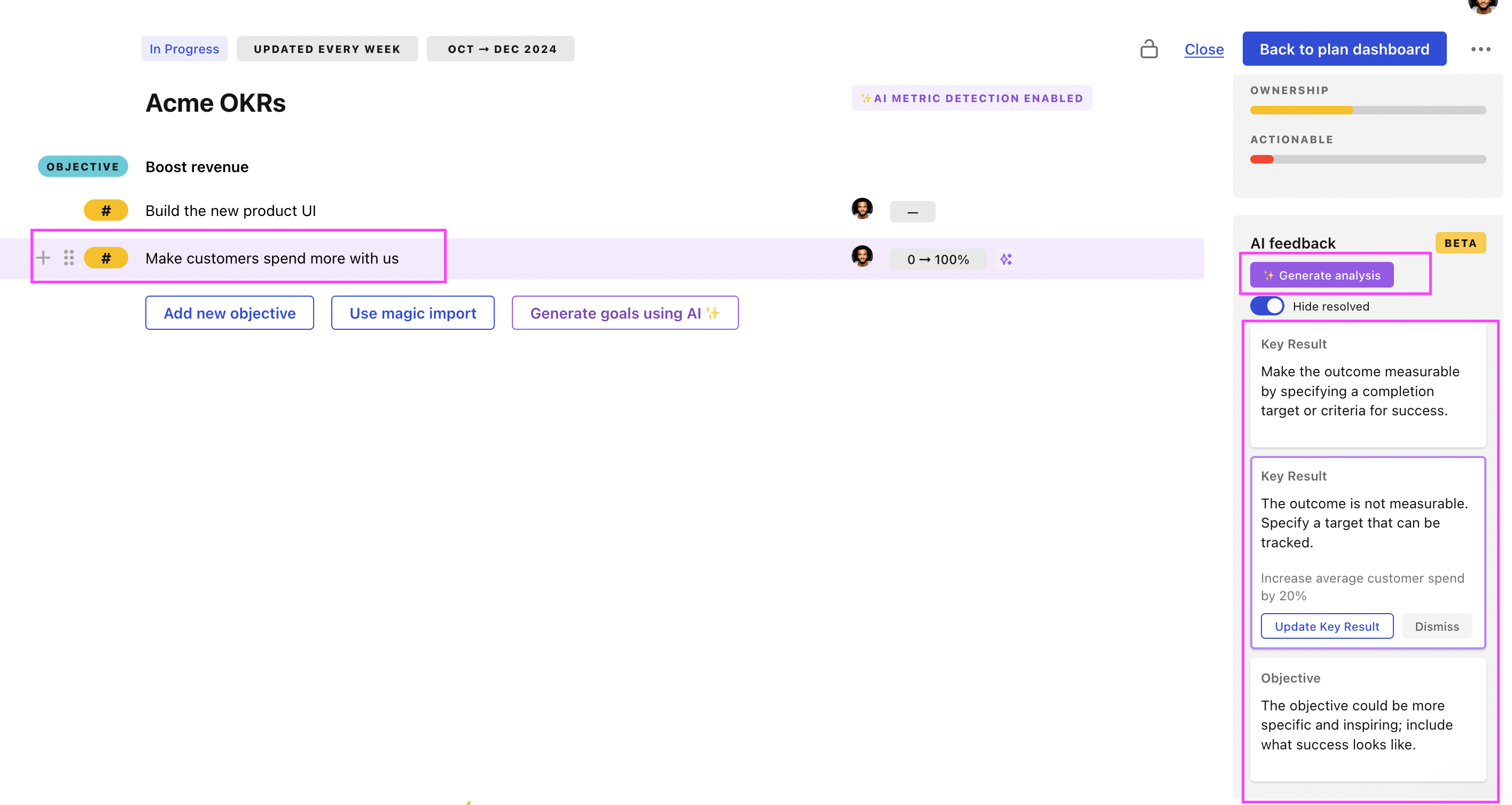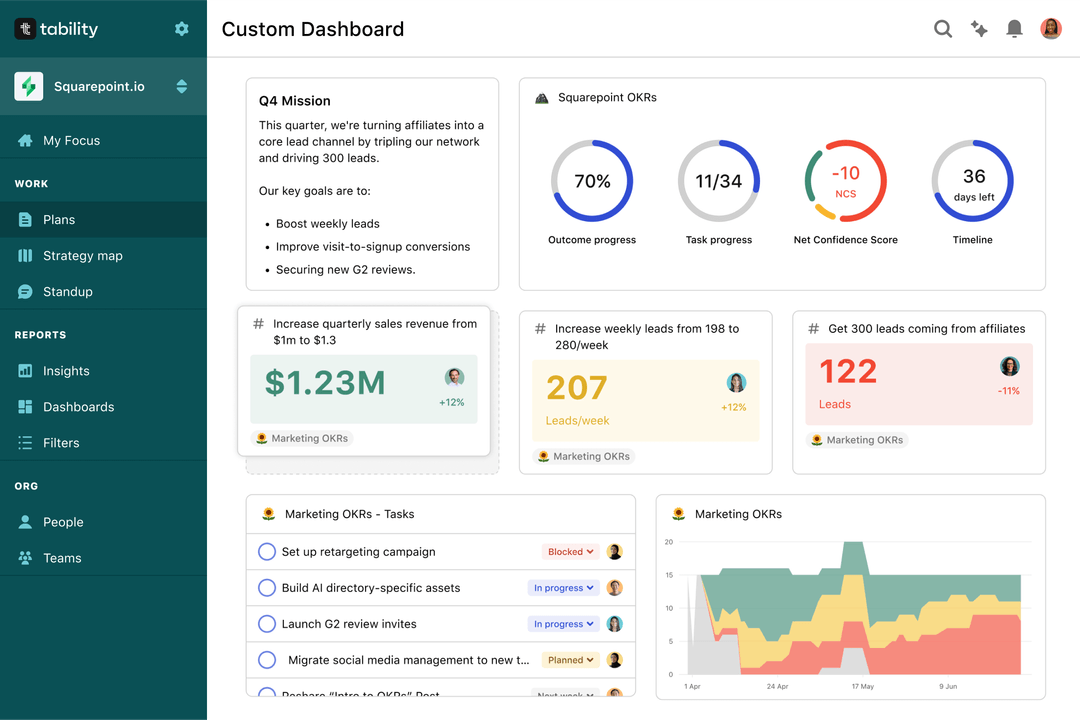Tability is a cheatcode for goal-driven teams. Set perfect OKRs with AI, stay focused on the work that matters.
What are Website Ux Designer OKRs?
The Objective and Key Results (OKR) framework is a simple goal-setting methodology that was introduced at Intel by Andy Grove in the 70s. It became popular after John Doerr introduced it to Google in the 90s, and it's now used by teams of all sizes to set and track ambitious goals at scale.
Creating impactful OKRs can be a daunting task, especially for newcomers. Shifting your focus from projects to outcomes is key to successful planning.
That's why we have created a list of OKRs examples for Website Ux Designer to help. You can use any of the templates below as a starting point to write your own goals.
If you want to learn more about the framework, you can read our OKR guide online.
The best tools for writing perfect Website Ux Designer OKRs
Here are 2 tools that can help you draft your OKRs in no time.
Tability AI: to generate OKRs based on a prompt
Tability AI allows you to describe your goals in a prompt, and generate a fully editable OKR template in seconds.
- 1. Create a Tability account
- 2. Click on the Generate goals using AI
- 3. Describe your goals in a prompt
- 4. Get your fully editable OKR template
- 5. Publish to start tracking progress and get automated OKR dashboards
Watch the video below to see it in action 👇
Tability Feedback: to improve existing OKRs
You can use Tability's AI feedback to improve your OKRs if you already have existing goals.
- 1. Create your Tability account
- 2. Add your existing OKRs (you can import them from a spreadsheet)
- 3. Click on Generate analysis
- 4. Review the suggestions and decide to accept or dismiss them
- 5. Publish to start tracking progress and get automated OKR dashboards

Tability will scan your OKRs and offer different suggestions to improve them. This can range from a small rewrite of a statement to make it clearer to a complete rewrite of the entire OKR.
Website Ux Designer OKRs examples
We've added many examples of Website Ux Designer Objectives and Key Results, but we did not stop there. Understanding the difference between OKRs and projects is important, so we also added examples of strategic initiatives that relate to the OKRs.
Hope you'll find this helpful!
OKRs to improve user navigation and orientation on the website
ObjectiveImprove user navigation and orientation on the website
KRAchieve 95% positive feedback on user interface and navigation ease
Implement user feedback for interface improvements
Offer in-app guidance for simplified navigation
Conduct a detailed usability testing of the interface
KRReduce website bounce rate by 15%
Ensure website content is relevant and engaging
Optimize website layout for easy navigation
Improve website loading speed to reduce visitor impatience
KRIncrease average session duration by 10%
Optimize page load times to reduce bounce rates
Improve website interface for more user-friendly navigation
Introduce engaging content to retain visitors longer
OKRs to improve mobile user experience for our ecommerce website
ObjectiveImprove mobile user experience for our ecommerce website
KRIncrease mobile navigation efficiency by reducing clicks by 20%
Improve search capabilities for user-friendly results
Implement quick-access shortcuts for key functions
Simplify menus to decrease depth and complexity
KRDecrease mobile page load time by 30%
Minimize use of heavy code and unnecessary plugins
Implement effective caching and content delivery network (CDN)
Optimize images for faster loading
KRImprove mobile conversion rate by 15%
Optimize site for mobile usability and readability
Enhance mobile site speed and overall user experience
Implement user-friendly mobile checkout process
OKRs to streamline Sign in and Registration process on eCommerce Website
ObjectiveStreamline Sign in and Registration process on eCommerce Website
KRReduce sign in and registration related support tickets by 15%
Conduct site-wide usability testing to identify problem areas
Implement user-friendly, intuitive sign in and registration process
Provide clear, simple instructions for the sign-up process
KRDecrease average sign in time by 30%
Implement auto-fill option for returning users
Optimize website's load time for faster access
Streamline the sign in process by removing unnecessary steps
KRIncrease registration conversion rate by 20%
Improve website speed and usability
Offer incentives for completing sign-ups
Simplify registration form to only essential information
OKRs to increase revenue and lead generation
ObjectiveIncrease revenue and lead generation
KRIncrease conversion rate by 15% through better website optimization and UX
Improve website navigation and user flow for a seamless user experience
Conduct a thorough website audit to identify areas for optimization
A/B test different landing page designs to identify the most effective layout
Streamline the checkout process to reduce friction and increase conversions
KRImprove lead response time to an average of less than 1 hour
Assign dedicated staff members to monitor and respond to leads promptly
Provide regular training to employees on effective and timely lead communication techniques
Streamline lead routing and distribution process to reduce response time
Implement an automated lead email notification system for immediate response
KRIncrease monthly revenue by 10% compared to previous quarter
Launch targeted marketing campaign to attract new customers
Improve product pricing strategy to increase customer spend
Offer discounts or promotions to incentivize repeat purchases
Enhance customer experience to encourage higher customer satisfaction and retention
KRGenerate 50% more qualified leads through targeted marketing campaigns
Create compelling and personalized content to engage target audience and drive conversions
Implement a data-driven approach to optimize marketing channels and increase lead generation
Conduct market research to identify target audience's preferences and pain points
Continuously analyze campaign performance and make necessary adjustments to maximize qualified leads
OKRs to enhance technical performance and usability of the website
ObjectiveEnhance technical performance and usability of the website
KRIncrease website traffic by 50% through SEO optimizations
Develop and implement a keyword optimization strategy
Increase the creation of high-quality, SEO-friendly content
Conduct a comprehensive SEO audit to identify improvement areas
KRImplement a responsive design, increasing mobile traffic by 40%
Test and debug mobile functionality regularly
Develop a responsive design layout for optimal mobile browsing
Optimize website speed for mobile users
KRReduce site loading time by 30% to improve user experience
Implement lazy loading for non-critical site elements
Minimize HTTP requests by combining CSS/JavaScript files
Optimize images and multimedia files for faster loading
OKRs to enhance web usability to boost conversions and lead quality
ObjectiveEnhance web usability to boost conversions and lead quality
KRDecrease bounce rate by 15% via improving website navigation
Implement intuitive, clear, and user-friendly navigation menus
Optimize page loading speed to decrease visitor frustration
Perform user experience testing and make necessary adjustments
KRReduce page load time by 20% to improve user experience
Optimize image sizes to improve webpage loading speeds
Remove unused scripts and unnecessary plugins
Implement Lazy-loading for content elements
KRIncrease conversion rate by 10% through refining call-to-actions
Implement successful changes site-wide
Conduct A/B testing on revised call-to-actions
Review existing call-to-actions for clarity and attraction
OKRs to boost Monthly Membership Subscriptions
ObjectiveBoost Monthly Membership Subscriptions
KRImplement member referral program, aiming for 15% new subscriptions
Train staff to promote and manage referral program
Develop structure and incentives for member referral program
Monitor program regularly, aiming for 15% new subscriptions
KREnhance website UX for 20% increase in membership conversion rates
Implement A/B testing for conversion optimization
Simplify signup forms and streamline onboarding
Conduct user testing to identify UX improvement areas
KRExecute 4 promotional membership campaigns to yield 25% growth
Design four different promotional membership campaigns
Adjust strategies based on campaign performances
Launch and monitor the effectiveness of these campaigns
OKRs to enhance the effectiveness and impact of the company newsletter
ObjectiveEnhance the effectiveness and impact of the company newsletter
KRAchieve a 10% click-through rate, reflecting enhanced user interaction
Optimize website UI/UX for seamless navigation
Develop engaging content to increase user interest
Implement A/B testing for effective CTA buttons
KRIncrease newsletter open rate by 20% through engaging content and subject lines
Research popular trends to integrate into the newsletter content
Enhance subject lines with compelling keywords or phrases
Test various email formats for optimal user engagement
KRGrow subscriber count by 15% via targeted promotion and referral program
Implement a beneficial referral program for members
Design engaging tailored promotions for existing subscribers
Regularly analyze and optimize campaign effectiveness
OKRs to boost IDV completion success for business clientele
ObjectiveBoost IDV completion success for business clientele
KRAchieve a 20% increase in successful IDV attempts by end of next quarter
KRImprove user experience leading to a 25% increase in client satisfaction survey scores
Enhance customer service response times and quality
Initiate regular customer feedback loops for continuous improvement
Revamp website layout for easy navigation and quick access
KRReduce by 15% the errors in the IDV process in the next quarter
Implement targeted training to address identified issues
Review and analyze errors in current IDV process
Monitor and adjust the IDV process regularly
Website Ux Designer OKR best practices
Generally speaking, your objectives should be ambitious yet achievable, and your key results should be measurable and time-bound (using the SMART framework can be helpful). It is also recommended to list strategic initiatives under your key results, as it'll help you avoid the common mistake of listing projects in your KRs.
Here are a couple of best practices extracted from our OKR implementation guide 👇
Tip #1: Limit the number of key results
Having too many OKRs is the #1 mistake that teams make when adopting the framework. The problem with tracking too many competing goals is that it will be hard for your team to know what really matters.
We recommend having 3-4 objectives, and 3-4 key results per objective. A platform like Tability can run audits on your data to help you identify the plans that have too many goals.
Tip #2: Commit to weekly OKR check-ins
Setting good goals can be challenging, but without regular check-ins, your team will struggle to make progress. We recommend that you track your OKRs weekly to get the full benefits from the framework.
Being able to see trends for your key results will also keep yourself honest.
Tip #3: No more than 2 yellow statuses in a row
Yes, this is another tip for goal-tracking instead of goal-setting (but you'll get plenty of OKR examples above). But, once you have your goals defined, it will be your ability to keep the right sense of urgency that will make the difference.
As a rule of thumb, it's best to avoid having more than 2 yellow/at risk statuses in a row.
Make a call on the 3rd update. You should be either back on track, or off track. This sounds harsh but it's the best way to signal risks early enough to fix things.
Save hours with automated Website Ux Designer OKR dashboards

Quarterly OKRs should have weekly updates to get all the benefits from the framework. Reviewing progress periodically has several advantages:
- It brings the goals back to the top of the mind
- It will highlight poorly set OKRs
- It will surface execution risks
- It improves transparency and accountability
Spreadsheets are enough to get started. Then, once you need to scale you can use Tability to save time with automated OKR dashboards, data connectors, and actionable insights.
How to get Tability dashboards:
- 1. Create a Tability account
- 2. Use the importers to add your OKRs (works with any spreadsheet or doc)
- 3. Publish your OKR plan
That's it! Tability will instantly get access to 10+ dashboards to monitor progress, visualise trends, and identify risks early.
More Website Ux Designer OKR templates
We have more templates to help you draft your team goals and OKRs.
OKRs to streamline publication of support agent knowledge articles
OKRs to enhance product quality in the dairy department
OKRs to optimize server capacity planning
OKRs to establish the Ethio Cyber Incident Response Team website
OKRs to ensure 100% accuracy in invoice rates
OKRs to improve staff retention and foster a positive work culture